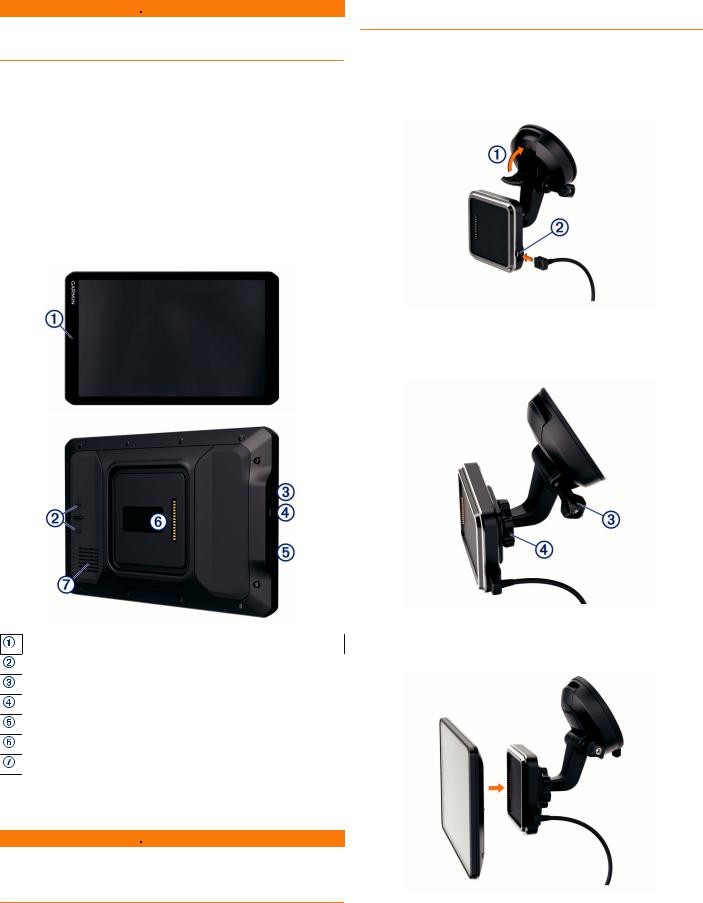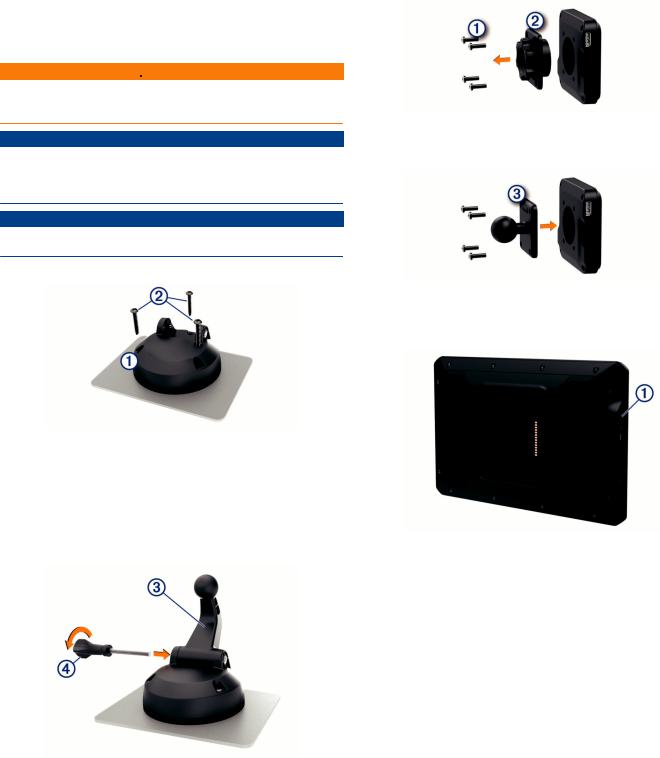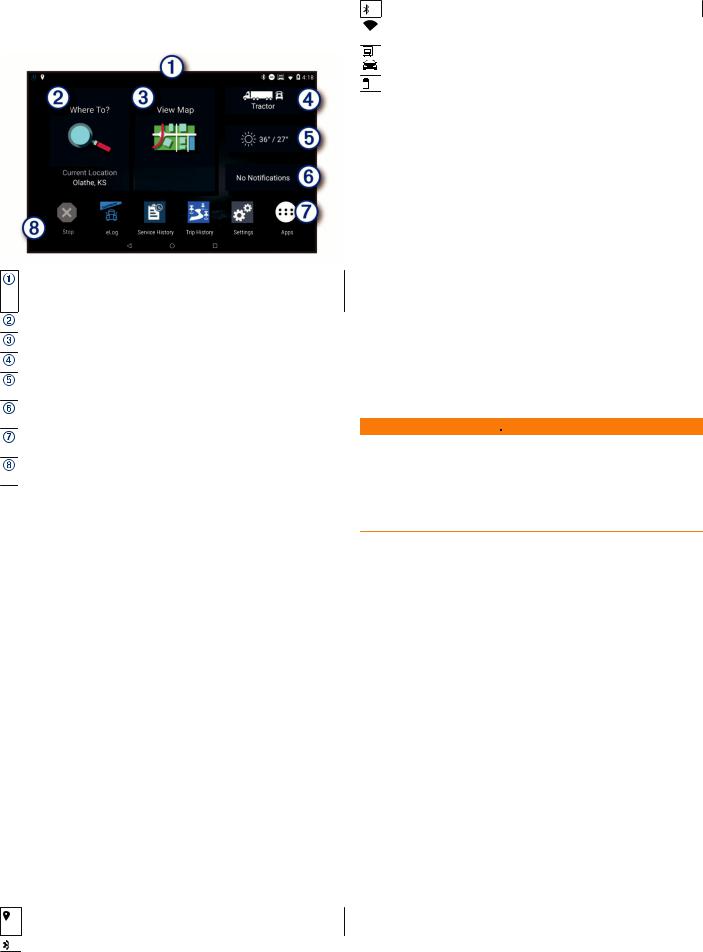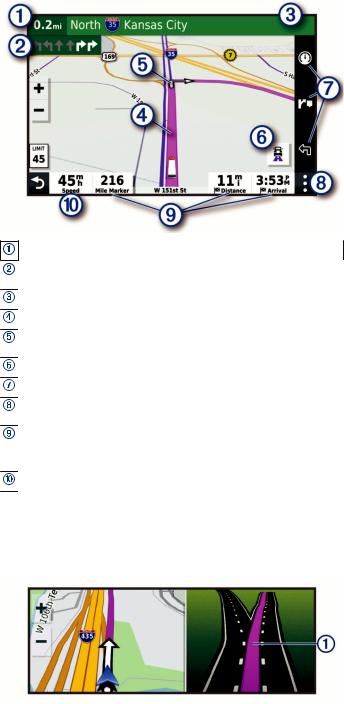Garmin Dezl LGV-800 User Manual

DĒZL™ OTR800 / OTR1000 /
LGV800 / LGV1000
Owner’s Manual
© 2020 Garmin Ltd. or its subsidiaries
All rights reserved. Under the copyright laws, this manual may not be copied, in whole or in part, without the written consent of Garmin. Garmin reserves the right to change or improve its products and to make changes in the content of this manual without obligation to notify any person or organization of such changes or improvements. Go to www.garmin.com for current updates and supplemental information concerning the use of this product.
Garmin® and the Garmin logo are trademarks of Garmin Ltd. or its subsidiaries, registered in the USA and other countries. These trademarks may not be used without the express permission of Garmin.
BC™, dēzl™, Garmin eLog™, Garmin Express™, and myTrends™ are trademarks of Garmin Ltd. or its subsidiaries. These trademarks may not be used without the express permission of Garmin.
Android™ is a trademark of Google Inc. Apple® and Mac® are trademarks of Apple Inc, registered in the U.S. and other countries. The Bluetooth® word mark and logos are owned by the Bluetooth SIG, Inc., and any use of such word mark or logo by Garmin is under license. Foursquare® is a trademark of Foursquare Labs, Inc. in the U.S. and in other countries. microSD® and the microSDHC logo are trademarks of SD-3C, LLC. TripAdvisor® is a registered trademark of TripAdvisor LLC. TruckDown® is the trademark of TruckDown Info International, Inc. Windows® is a registered trademark of Microsoft Corporation in the United States and other countries. Wi Fi® and Wi Fi CERTIFIED MiraCast™ are registered marks of Wi-Fi Alliance Corporation.
Table of Contents |
|
Getting Started............................................................... |
1 |
Device Overview ......................................................................... |
1 |
Mounting and Powering the Device in Your Vehicle ................... |
1 |
Installing the Screw-Down Mount on the Dashboard ............. |
2 |
Installing the Ball Mount Adapter ........................................... |
2 |
Turning the Device On or Off ...................................................... |
2 |
Acquiring GPS Signals ............................................................... |
2 |
Home Screen .............................................................................. |
3 |
Opening an App ..................................................................... |
3 |
Adding Shortcuts to the Home Screen .................................. |
3 |
Viewing Notifications .............................................................. |
3 |
Status Bar Icons ..................................................................... |
3 |
Using the Touchscreen ............................................................... |
3 |
Adjusting the Screen Brightness ................................................ |
3 |
Vehicle Profiles............................................................... |
3 |
Adding a Vehicle Profile .............................................................. |
3 |
Car Profile ................................................................................... |
4 |
Switching the Vehicle Profile ...................................................... |
4 |
Changing Your Trailer Information .............................................. |
4 |
Editing a Vehicle Profile .............................................................. |
4 |
Driver Awareness Features and Alerts........................ |
4 |
Enabling or Disabling Driver Alerts ............................................. |
4 |
Red Light and Speed Cameras .................................................. |
4 |
Navigating to Your Destination..................................... |
5 |
Routes ........................................................................................ |
5 |
Starting a Route .......................................................................... |
5 |
Starting a Route by Using the Map ........................................ |
5 |
Going Home ........................................................................... |
5 |
Your Route on the Map ............................................................... |
5 |
Active Lane Guidance ............................................................ |
5 |
Viewing Popular Truck Paths on the Map .............................. |
5 |
Viewing Turns and Directions ................................................ |
5 |
Viewing the Entire Route on the Map .................................... |
6 |
Arriving at Your Destination ........................................................ |
6 |
Completing a Truck Route ..................................................... |
6 |
Parking Near Your Destination .............................................. |
6 |
Changing Your Active Route ...................................................... |
6 |
Adding a Location to Your Route ........................................... |
6 |
Shaping Your Route ............................................................... |
6 |
Taking a Detour ..................................................................... |
6 |
Changing the Route Calculation Mode .................................. |
7 |
Stopping the Route ..................................................................... |
7 |
Using Suggested Routes ............................................................ |
7 |
Avoiding Delays, Tolls, and Areas .............................................. |
7 |
Avoiding Traffic Delays on Your Route .................................. |
7 |
Avoiding Toll Roads ............................................................... |
7 |
Avoiding Toll Stickers ............................................................. |
7 |
Avoiding Road Features ........................................................ |
7 |
Avoiding Environmental Zones .............................................. |
7 |
Custom Avoidances ............................................................... |
7 |
Finding and Saving Locations...................................... |
8 |
Points of Interest ......................................................................... |
8 |
Finding Trucking Points of Interest ............................................. |
8 |
Finding a Location Using the Search Bar ................................... |
8 |
Finding an Address ..................................................................... |
8 |
Finding a Location by Category .................................................. |
8 |
Searching Within a Category ................................................. |
8 |
Location Search Results ............................................................. |
8 |
Changing the Search Area ......................................................... |
9 |
Custom Points of Interest ........................................................... |
9 |
Installing POI Loader ............................................................. |
9 |
Finding Custom POIs ............................................................. |
9 |
Parking ........................................................................................ |
9 |
Finding Truck Parking ............................................................ |
9 |
Finding Truck Parking in Europe ............................................ |
9 |
Finding Parking Near Your Current Location ......................... |
9 |
Understanding Parking Colors and Symbols ......................... |
9 |
Search Tools ............................................................................... |
9 |
Finding an Intersection ........................................................... |
9 |
Finding a Location Using Coordinates ................................... |
9 |
Foursquare ................................................................................. |
9 |
Connecting to Your Foursquare Account ............................... |
9 |
Searching Foursquare Points of Interest ............................... |
9 |
Viewing Foursquare Location Details .................................. |
10 |
TripAdvisor ................................................................................ |
10 |
Finding TripAdvisor Points of Interest .................................. |
10 |
Viewing Recently Found Locations .......................................... |
10 |
Clearing the List of Recently Found Locations .................... |
10 |
Viewing Current Location Information ...................................... |
10 |
Finding Emergency Services and Fuel ................................ |
10 |
Getting Directions to Your Current Location ........................ |
10 |
Adding a Shortcut ..................................................................... |
10 |
Removing a Shortcut ........................................................... |
10 |
Saving Locations ...................................................................... |
10 |
Saving a Location ................................................................ |
10 |
Saving Your Current Location .............................................. |
10 |
Editing a Saved Location ..................................................... |
10 |
Assigning Categories to a Saved Location .......................... |
10 |
Deleting a Saved Location ................................................... |
11 |
Using the Map............................................................... |
11 |
Map Tools ................................................................................. |
11 |
Viewing a Map Tool ............................................................. |
11 |
Up Ahead .................................................................................. |
11 |
Viewing Upcoming Locations ............................................... |
11 |
Customizing the Up Ahead Categories ................................ |
11 |
Cities Ahead ............................................................................. |
11 |
Viewing Upcoming Cities and Exit Services ........................ |
11 |
Warning and Alert Symbols ...................................................... |
11 |
Restriction Warnings ............................................................ |
12 |
Road Condition Warnings .................................................... |
12 |
Alerts .................................................................................... |
12 |
Trip Information ......................................................................... |
12 |
Viewing Trip Data from the Map .......................................... |
12 |
Viewing the Trip Log ............................................................ |
12 |
Resetting Trip Information .................................................... |
12 |
Viewing Upcoming Traffic ......................................................... |
12 |
Viewing Traffic on the Map .................................................. |
12 |
Searching for Traffic Incidents ............................................. |
12 |
Customizing the Map ................................................................ |
12 |
Customizing the Map Layers ............................................... |
12 |
Changing the Map Data Field .............................................. |
12 |
Changing the Map Perspective ............................................ |
12 |
Live Services, Traffic, and Smartphone Features..... |
12 |
Pairing with Your Smartphone .................................................. |
13 |
Tips After Pairing the Devices .............................................. |
13 |
Pairing Additional Bluetooth Devices ................................... |
13 |
Going to an Address or Location Using the Garmin Drive |
|
App ........................................................................................... |
13 |
Smart Notifications .................................................................... |
13 |
Receiving Notifications ......................................................... |
13 |
Hands-Free Calling ................................................................... |
13 |
Placing a Call ....................................................................... |
13 |
Receiving a Call ................................................................... |
13 |
Using In-Call Options ........................................................... |
13 |
Saving a Phone Number as a Preset .................................. |
14 |
Wireless Headsets .................................................................... |
14 |
Enabling or Disabling Bluetooth Features ................................ |
14 |
Showing or Hiding App Notifications (Android™) ................ |
14 |
Table of Contents |
i |
Showing or Hiding Notification Categories for Your Apple® |
|
Device .................................................................................. |
14 |
Disconnecting a Bluetooth Device ............................................ |
14 |
Deleting a Paired Bluetooth Device .......................................... |
14 |
Deleting a Paired Phone ........................................................... |
14 |
Traffic............................................................................ |
14 |
Receiving Traffic Data Using Your Smartphone ....................... |
14 |
Viewing Traffic on the Map ....................................................... |
14 |
Searching for Traffic Incidents ............................................. |
14 |
photoLive Traffic Cameras ........................................................ |
14 |
Viewing and Saving photoLive Traffic Cameras .................. |
14 |
Saving a Traffic Camera ...................................................... |
15 |
Vehicle and Driver Tools............................................. |
15 |
Break Planning ......................................................................... |
15 |
Taking a Suggested Break .................................................. |
15 |
Starting the Break Timer ...................................................... |
15 |
Pausing and Resetting the Break Timer .............................. |
15 |
Adjusting Drive Hours .......................................................... |
15 |
Adjusting the Daily Driving Limit .......................................... |
15 |
IFTA .......................................................................................... |
15 |
Entering Fuel Data ............................................................... |
15 |
Editing Fuel Data ................................................................. |
15 |
Viewing and Exporting a Jurisdiction Summary ................... |
15 |
Editing and Exporting Trip Reports ...................................... |
15 |
Viewing Exported Jurisdiction Summaries and Trip |
|
Reports ................................................................................ |
16 |
Logging Service History ............................................................ |
16 |
Adding Service Categories .................................................. |
16 |
Deleting Service Categories ................................................ |
16 |
Renaming Service Categories ............................................. |
16 |
Deleting Service Records .................................................... |
16 |
Editing a Service Record ..................................................... |
16 |
Garmin eLog................................................................. |
16 |
Setting Up Your Garmin eLog Adapter ..................................... |
16 |
Transferring Garmin eLog Data from Another Device .............. |
16 |
Backing Up Data .................................................................. |
16 |
Restoring Data ..................................................................... |
17 |
Daily Operation Guidelines ....................................................... |
17 |
Starting a Drive ......................................................................... |
17 |
Garmin eLog App Overview ................................................. |
17 |
Garmin eLog Map Tool Overview ........................................ |
17 |
Driving in a Team ................................................................. |
18 |
Changing Duty Status .......................................................... |
18 |
Viewing Hours of Service ..................................................... |
18 |
Recording Adverse Conditions ............................................ |
18 |
Reviewing Logs .................................................................... |
18 |
Certifying Daily Logs ............................................................ |
18 |
Submitting a Daily Log ......................................................... |
18 |
Exporting and Saving a Record of Duty Status (RODS) |
|
Report .................................................................................. |
18 |
Recording Trailers and Shipments ....................................... |
18 |
Roadside Inspection ................................................................. |
19 |
Viewing Inspection Information ............................................ |
19 |
Transferring Data to an Inspector Using a USB Device ...... |
19 |
Transferring Data to an Inspector Using Bluetooth Wireless |
|
Technology .......................................................................... |
19 |
Diagnostics and Malfunctions ................................................... |
19 |
Viewing Diagnostics and Malfunctions ................................ |
19 |
Diagnostic Definitions .......................................................... |
19 |
Malfunction Definitions ......................................................... |
20 |
Administrator Functions ............................................................ |
20 |
Adding Driver Profiles .......................................................... |
20 |
Editing a Driver Profile ......................................................... |
21 |
Clearing Garmin eLog App Data .......................................... |
21 |
Voice Command........................................................... |
21 |
Tips for Speaking to the Device ................................................ |
21 |
Launching Garmin Voice-Activated Navigation ........................ |
21 |
Checking Your Arrival Time ...................................................... |
21 |
Placing a Phone Call Using Your Voice ................................... |
21 |
Changing Device Settings Using Your Voice ........................... |
21 |
Using the Apps............................................................. |
21 |
Viewing the Owner's Manual on Your Device ........................... |
21 |
Viewing the Truck Map ............................................................. |
21 |
Trip Planner .............................................................................. |
21 |
Planning a Trip ..................................................................... |
21 |
Editing and Reordering Locations in a Trip .......................... |
22 |
Discovering Attractions Along Your Trip .............................. |
22 |
Changing Routing Options for a Trip ................................... |
22 |
Navigating to a Saved Trip ................................................... |
22 |
Editing and Saving Your Active Route ................................. |
22 |
Viewing Previous Routes and Destinations .............................. |
22 |
Viewing the Weather Forecast .................................................. |
22 |
Viewing Weather Near a Different City ................................ |
22 |
Settings......................................................................... |
22 |
Navigation Settings ................................................................... |
22 |
Map and Vehicle Settings ......................................................... |
22 |
Enabling Maps ..................................................................... |
23 |
Connecting to a Wireless Network ............................................ |
23 |
Enabling Bluetooth Wireless Technology ................................. |
23 |
Driver Assistance Settings ........................................................ |
23 |
Traffic Settings .......................................................................... |
23 |
Display Settings ........................................................................ |
23 |
Sound and Notification Settings ............................................... |
23 |
Adjusting Sound and Notification Volume ............................ |
23 |
Enabling or Disabling Location Services .................................. |
23 |
Setting the Text Language ....................................................... |
23 |
Date and Time Settings ............................................................ |
24 |
Device Settings ......................................................................... |
24 |
Restoring Settings .................................................................... |
24 |
Device Information....................................................... |
24 |
Viewing E-label Regulatory and Compliance Information ........ |
24 |
Specifications ............................................................................ |
24 |
Charging the Device ................................................................. |
24 |
Device Maintenance..................................................... |
24 |
Garmin Support Center ............................................................. |
24 |
Updating Maps and Software Using a Wi Fi Network .............. |
24 |
Updating Maps and Software with Garmin Express ................. |
24 |
Installing Garmin Express .................................................... |
25 |
Device Care .............................................................................. |
25 |
Cleaning the Outer Casing ................................................... |
25 |
Cleaning the Touchscreen ................................................... |
25 |
Avoiding Theft ...................................................................... |
25 |
Resetting the Device ................................................................. |
25 |
Removing the Device, Mount, and Suction Cup ....................... |
25 |
Removing the Mount from the Suction Cup ......................... |
25 |
Removing the Suction Cup from the Windshield ................. |
25 |
Troubleshooting........................................................... |
25 |
The suction cup will not stay on my windshield ........................ |
25 |
The mount does not hold my device in place while I drive ....... |
26 |
My device is not acquiring satellite signals ............................... |
26 |
The device does not charge in my vehicle ............................... |
26 |
My battery does not stay charged for very long ........................ |
26 |
My device does not connect to my phone ................................ |
26 |
Appendix....................................................................... |
26 |
Backup Cameras ...................................................................... |
26 |
Pairing a BC™ 35 Backup Camera with a Garmin Navigation |
|
Device .................................................................................. |
26 |
Viewing the Backup Camera ................................................ |
26 |
Connecting a Dash Camera to the Powered Mount ................. |
26 |
ii |
Table of Contents |
Data Management .................................................................... |
27 |
About Memory Cards ........................................................... |
27 |
Installing a Memory Card for Maps and Data ...................... |
27 |
Formatting the Memory Card ............................................... |
27 |
Connecting the Device to Your Computer ........................... |
27 |
Transferring Data From Your Computer .............................. |
27 |
Purchasing Additional Maps ..................................................... |
27 |
Purchasing Accessories ........................................................... |
27 |
Index.............................................................................. |
28 |
Table of Contents |
iii |

Getting Started
 WARNING
WARNING
See the Important Safety and Product Information guide in the product box for product warnings and other important information.
•Update the maps and software on your device (Updating Maps and Software Using a Wi Fi Network, page 24).
•Mount the device in your vehicle and connect it to power (Mounting and Powering the Device in Your Vehicle, page 1).
•Adjust the volume (Adjusting Sound and Notification Volume, page 23) and display brightness (Adjusting the Screen Brightness, page 3).
•Set up a vehicle profile for your truck (Adding a Vehicle Profile, page 3).
•Navigate to your destination (Starting a Route, page 5).
Device Overview
Microphone for hands-free calling and voice command
Volume control
Power key
Micro USB power and data port
Map and data memory card slot
Magnetic mount interface with 14-pin connector
Speaker
Mounting and Powering the Device in Your
Vehicle
 WARNING
WARNING
This product contains a lithium-ion battery. To prevent the possibility of personal injury or product damage caused by battery exposure to extreme heat, store the device out of direct sunlight.
Both the device and its mount contain magnets. Under certain circumstances, magnets may cause interference with some
internal medical devices and electronic devices, including pacemakers, insulin pumps, or hard drives in laptop computers. Keep the device away from medical devices and electronic devices.
Before you use your device on battery power, you should charge it.
1Open the lever  , press the suction cup to the windshield, and flip the lever back toward the windshield.
, press the suction cup to the windshield, and flip the lever back toward the windshield.
The lever must be oriented toward the top of the windshield.
2 Plug the vehicle power cable into the port  on the mount.
on the mount.
3If necessary, loosen the thumbscrew on the suction cup arm
 and the nut on the ball mount
and the nut on the ball mount  , and adjust the mount for better viewing and operation.
, and adjust the mount for better viewing and operation.
4Tighten the thumbscrew on the suction cup arm and the nut on the ball mount.
5 Place the device onto the magnetic mount.
6Plug the other end of the vehicle power cable into a power outlet in your vehicle.
Getting Started |
1 |

Installing the Screw-Down Mount on the Dashboard
Before you can attach the screw-down ball mount to your dashboard, you must select a suitable location on the dashboard.
 WARNING
WARNING
It is your responsibility to ensure the mounting location complies with all applicable laws and ordinances, and does not block your view of the road during the safe operation of your vehicle.
NOTICE
Avoid wires, gauges, air bags, air bag covers, HVAC, and other items when drilling pilot holes and attaching the mount to the vehicle. Garmin® is not responsible for any damages or consequences arising from the installation.
NOTICE
Garmin recommends professional installation of the screw-down ball mount.
1 Place the mount  on the selected location.
on the selected location.
2Using the mount as a template, mark the three screw locations.
3 Drill pilot holes (optional).
For some types of mounting material, drilling pilot holes is necessary.
4Securely fasten the mount to the surface using the supplied screws  .
.
5 Insert the ball mount arm  into the mount.
into the mount.
6Insert the thumbscrew  into the mount, and tighten it to secure the ball mount arm.
into the mount, and tighten it to secure the ball mount arm.
Installing the Ball Mount Adapter
Your device includes a one-inch ball mount that is compatible with third-party mounting solutions.
1Remove the four screws  securing the mount socket
securing the mount socket  to the magnetic mount.
to the magnetic mount.
2 Remove the mount socket.
3Secure the one-inch ball mount  to the magnetic mount using the screws removed in step 1.
to the magnetic mount using the screws removed in step 1.
Turning the Device On or Off
•To turn the device on, press the power key  , or connect the device to power.
, or connect the device to power.
•To put the device in power saving mode, press the power key while the device is on.
While in power saving mode, the screen is off and the device uses very little power, but it can wake instantly for use.
TIP: You can charge your device faster by putting it in power saving mode while charging the battery.
•To turn off the device completely, hold the power key until a prompt appears on the screen, and select Power Off.
Acquiring GPS Signals
When you turn on your navigation device, the GPS receiver must collect satellite data and establish the current location. The time required to acquire satellite signals varies based on several factors, including how far you are from the location where you last used your navigation device, whether you have a clear view of the sky, and how long it has been since you last used your navigation device. The first time you turn on your navigation device, it may take several minutes to acquire satellite signals.
1 Turn on the device.
2Verify  appears in the status bar, and enable location services if it does not (Enabling or Disabling Location Services, page 23).
appears in the status bar, and enable location services if it does not (Enabling or Disabling Location Services, page 23).
3If necessary, go to an open area with a clear view of the sky, away from tall buildings and trees.
Acquiring Satellites appears at the top of the navigation map until the device determines your location.
2 |
Getting Started |

Home Screen
NOTE: The home screen layout may vary if it has been customized.
Swipe down to view notifications.
Swipe down twice to quickly change settings and backlight brightness.
Select to start a route.
Select to view the map.
Select to change your vehicle profile.
Select to view weather information for your current location. The Garmin Drive™ app is required.
Select to view smart notifications. The Garmin Drive app is required.
Select to open the app drawer. The app drawer contains shortcuts to all the apps installed on your device.
Hold to customize the wallpaper or add widgets to the home screen.
Opening an App
The home screen contains shortcuts for frequently used apps. The app drawer contains all the apps installed on your device, organized into two tabs. The dēzl tab contains Garmin apps useful for navigation, dispatching, and hours of service recording. The Tools tab contains apps useful for communication and other tasks.
Select an option to open an app:
•Select an app shortcut from the home screen.
•Select  , select a tab, and select an app.
, select a tab, and select an app.
Adding Shortcuts to the Home Screen 1 Select  .
.
2 Select an app tab to view additional applications.
3Hold an application, and drag it to a location on the home screen.
Viewing Notifications
1Swipe down from the top of the screen. The list of notifications appears.
2Select an option:
•To launch the action or app mentioned in the notification, select the notification.
•To dismiss a notification, swipe the notification to the right.
Status Bar Icons
The status bar is located at the top of the main menu. The status bar icons display information about features on the device.
Location services is enabled (Enabling or Disabling Location
Services, page 23).
Bluetooth® technology is enabled.
Connected to a Bluetooth device.
Connected to a Wi Fi® network (Connecting to a Wireless Network, page 23).
Active vehicle profile. Swipe down twice and select to view the vehicle profile settings (Vehicle Profiles, page 3).
Battery charge level.
Using the Touchscreen
•Tap the screen to select an item.
•Drag or swipe your finger across the screen to pan or scroll.
•Pinch two fingers together to zoom out.
•Spread two fingers apart to zoom in.
Adjusting the Screen Brightness
The device can use an ambient light sensor to adjust the screen brightness to your vehicle conditions automatically (Display Settings, page 23). You can also adjust the brightness manually, using either the notification panel or the settings menu.
1Select an option:
•Swipe down twice from the top of the screen to expand the quick settings in the notification panel.
•Select Settings > Device > Display > Brightness Level.
2 Use the slider bar to adjust the brightness.
Vehicle Profiles
 WARNING
WARNING
Entering your vehicle profile characteristics does not guarantee that your vehicle's characteristics will be accounted for in all route suggestions or that you will receive the warning icons in all cases. Limitations may exist in the map data such that your device cannot account for these restrictions or road conditions in all cases. Always defer to all posted road signs and road conditions when making driving decisions.
Routing and navigation are calculated differently based on your vehicle profile. The activated vehicle profile is indicated by an icon in the status bar. The navigation and map settings on your device can be customized separately for each vehicle type.
When you activate a truck vehicle profile, the device avoids including restricted or impassable areas in routes based on the dimensions, weight, and other characteristics you entered for your vehicle.
Adding a Vehicle Profile
You can add a vehicle profile that includes the weight, dimensions, and other characteristics for your vehicle.
1From the home screen, select the vehicle profile widget (Home Screen, page 3).
2Select an option:
•To add a straight truck with a permanently attached cargo area, select Straight Truck.
•To add a tractor or a tractor-trailer combination, select
Tractor.
•To add a bus, select Bus.
3Follow the on-screen instructions to enter the vehicle characteristics.
After you add a vehicle profile, you can edit the profile to enter additional detailed information, such as the vehicle identification number or trailer number (Editing a Vehicle Profile, page 4).
Vehicle Profiles |
3 |

Car Profile
The car profile is a preloaded vehicle profile intended for use in an automobile without a trailer. While using the car profile, the device calculates standard automobile routes, and routing for large vehicles is not available. Some features and settings specific to large vehicles are not available while using the car profile.
Switching the Vehicle Profile
Each time you turn on your device, it prompts you to select a vehicle profile. You can manually switch to another vehicle profile at any time.
1Select an option:
•Swipe down twice from the top of the screen, and select the vehicle profile icon, such as  or
or  .
.
•From the home screen, select the vehicle profile widget (Home Screen, page 3).
2 Select a vehicle profile.
The vehicle profile information appears, including measurements and weight.
3 Select Select.
Changing Your Trailer Information
Before you can change your trailer information, you must enter a vehicle profile for a tractor (Adding a Vehicle Profile, page 3).
When you change the trailer on your tractor, you can change the trailer information in your vehicle profile without changing the tractor information. You can switch quickly between frequently used trailers.
1From the home screen, select the vehicle profile widget (Home Screen, page 3).
2 Select the tractor vehicle profile to use with the trailer. 3 Select  .
.
4Select an option:
•To use a recent trailer configuration, select a trailer configuration from the list.
•To enter a new trailer configuration, select New Configuration, and enter the trailer information.
Editing a Vehicle Profile
You can edit a vehicle profile to change vehicle information or to add detailed information to a new vehicle profile, such as the vehicle identification number, trailer number, or odometer reading. You can also rename or delete a vehicle profile.
1From the home screen, select the vehicle profile widget (Home Screen, page 3).
2 Select the vehicle profile to edit.
3Select an option:
•To edit the vehicle profile information, select  , and select a field to edit.
, and select a field to edit.
•To rename a vehicle profile, select  >
>  > Rename Profile.
> Rename Profile.
•To delete the vehicle profile, select  >
>  > Delete.
> Delete.
Driver Awareness Features and Alerts
NOTICE
The driver alerts and speed limit features are for information only and do not replace your responsibility to abide by all posted speed limit signs and to use safe driving judgment at all times. Garmin is not responsible for any traffic fines or citations you receive for failing to follow all applicable traffic laws and signs.
Your device provides features that can help encourage safer driving and increase efficiency, even when you are driving in a familiar area. The device plays an audible tone or message and displays information for each alert. You can enable or disable the audible tone for some types of driver alerts. Not all alerts are available in all areas.
Schools: The device plays a tone and displays the distance to and speed limit (if available) for an upcoming school or school zone.
Speed limit reduction: The device plays a tone and displays the upcoming reduced speed limit so you can be prepared to reduce your speed.
Speed limit exceeded: The device plays a tone and displays a red border on the speed limit icon when you exceed the posted speed limit for the current road.
Speed limit change: The device plays a tone and displays the upcoming speed limit so you can be prepared to adjust your speed.
Railroad crossing: The device plays a tone and displays the distance to an upcoming railroad crossing.
Animal crossing: The device plays a tone and displays the distance to an upcoming animal crossing area.
Curves: The device plays a tone and displays the distance to a curve in the road.
Slower traffic: The device plays a tone and displays the distance to slower traffic when you approach slower traffic at a higher speed. Your device must be receiving traffic information to use this feature (Traffic, page 14).
No trucks allowed: The device plays a tone when you approach a road where no trucks are allowed.
Risk of grounding: The device plays a tone and displays a message when you approach a road where your vehicle could become grounded.
Lateral wind: The device plays a tone and displays a message when you approach a road where there is risk of lateral wind.
Narrow road: The device plays a tone and displays a message when you approach a road that may be too narrow for your vehicle.
Steep hill: The device plays a tone and displays a message when you approach a steep hill.
State and country borders: The device plays a tone and displays a message when you approach the border of a state or country.
Enabling or Disabling Driver Alerts
You can enable or disable several types of driver alerts.
1Select Settings > Driver Assistance > Audible Driver Alerts.
2 Select or clear the check box next to each alert.
Red Light and Speed Cameras
NOTICE
Garmin is not responsible for the accuracy of or the consequences of using a red light or speed camera database.
NOTE: This feature is not available for all regions or product models.
Information about red light and speed camera locations is available in some areas for some product models. The device alerts you when you approach a reported speed or red light camera.
•In some areas, your device can receive live red light and speed camera data while connected to a smartphone running the Garmin Drive app.
4 |
Driver Awareness Features and Alerts |

•You can use the Garmin Express™ software (garmin.com /express) to update the camera database stored on your device. You should update your device frequently to receive the most up-to-date camera information.
Navigating to Your Destination
Routes
A route is a path from your current location to one or more destinations.
•The device calculates a recommended route to your destination based on the preferences you set, including the route calculation mode (Changing the Route Calculation Mode, page 7) and avoidances (Avoiding Delays, Tolls, and Areas, page 7).
•The device can automatically avoid roads that are not appropriate for the active vehicle profile.
•You can start navigating to your destination quickly using the recommended route, or you can select an alternate route (Starting a Route, page 5).
•If there are specific roads you need to use or avoid, you can customize the route (Shaping Your Route, page 6).
•You can add multiple destinations to a route (Adding a Location to Your Route, page 6).
Starting a Route
1Select Where To?, and search for a location (Finding and Saving Locations, page 8).
2 Select a location.
3Select an option:
•To start navigating using the recommended route, select
Go!.
•To choose an alternate route, select  , and select a route. Alternate routes appear to the right of the map.
, and select a route. Alternate routes appear to the right of the map.
•To edit the course of the route, select  > Edit Route, and add shaping points to the route (Shaping Your Route, page 6).
> Edit Route, and add shaping points to the route (Shaping Your Route, page 6).
The device calculates a route to the location and guides you using voice prompts and information on the map (Your Route on the Map, page 5). A preview of the major roads in your route appears at the edge of the map for several seconds.
If you need to stop at additional destinations, you can add the locations to your route (Adding a Location to Your Route, page 6).
Starting a Route by Using the Map
You can start route by selecting a location from the map. 1 Select View Map.
2 Drag and zoom the map to display the area to search.
3Select a point, such as a street, intersection, or address location.
4 Select Go!.
Going Home
The first time you start a route home, the device prompts you to enter your home location.
1 Select Where To? > Go Home.
2 If necessary, enter your home location.
Editing Your Home Location
1 Select Where To? >  > Set Home Location.
> Set Home Location.
2 Enter your home location.
Your Route on the Map
As you travel, the device guides you to your destination using voice prompts and information on the map. Instructions for your next turn or exit, or other actions appear across the top of the map.
Distance to the next action.
Next action in the route. Indicates the next turn, exit, or other action and the lane in which you should travel, if available.
Name of the street or exit associated with the next action.
Route highlighted on the map.
Next action in the route. Arrows on the map indicate the location of upcoming actions.
Select to toggle popular truck routes on the map.
Map tool shortcuts.
Map tools. You can select the tools to show you more information about your route and surroundings.
Data fields.
TIP: You can touch these fields to change the information they show (Changing the Map Data Field, page 12).
Vehicle speed.
Active Lane Guidance
As you approach some turns, exits, or interchanges in your route, a detailed simulation of the road appears beside the map, if available. A colored line  indicates the proper lane for the turn.
indicates the proper lane for the turn.
Viewing Popular Truck Paths on the Map
You can enable the device to highlight popular truck paths on the map. This can be useful to help you choose roads that are more accessible for your vehicle.
From the map, select  .
.
Viewing Turns and Directions
While navigating a route, you can view upcoming turns, lane changes, or other directions for your route.
1From the map, select an option:
•To view upcoming turns and directions as you navigate, select  > Turns.
> Turns.
Navigating to Your Destination |
5 |
